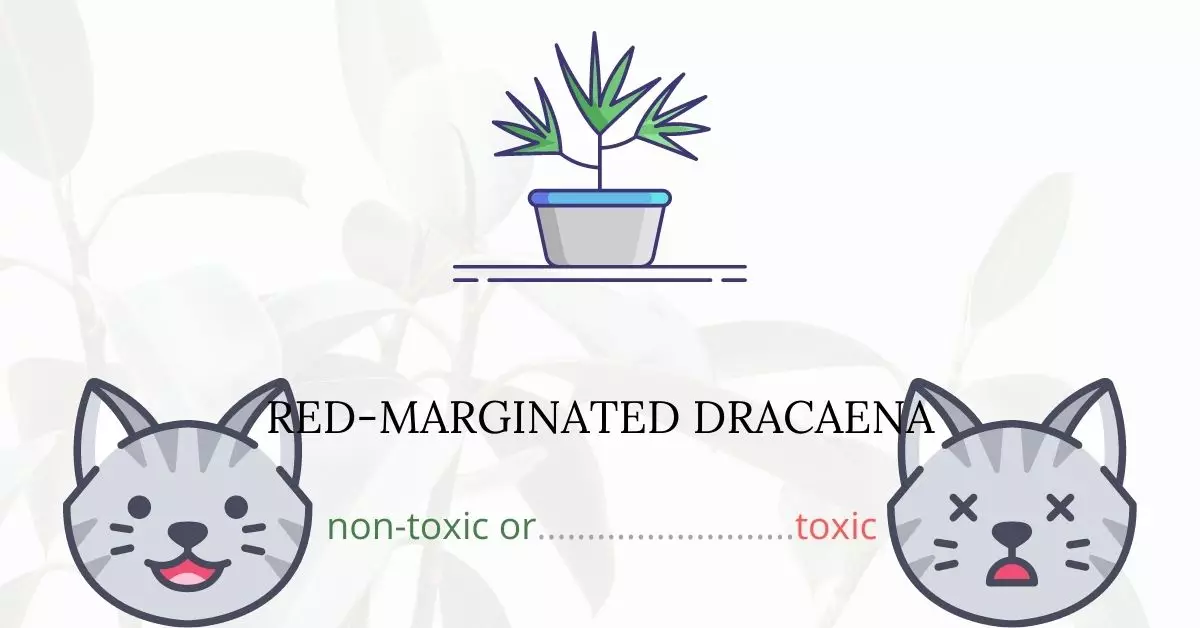Yes, Red-marginated Dracaena is considered toxic to cats. While there is occasional debate due to the absence of a specifically identified toxin, it is known that various components of the plant, possibly steroidal saponins or other alkaloids, can cause adverse reactions in cats when ingested. These reactions can manifest as vomiting or the expulsion of the plant material undigested from the intestines.
This article is the product of a collaborative effort with a team of experienced DVMs (doctors of veterinary medicine). With their insights, we are equipped to offer precise and current information about the risks associated with specific plants, including Red-marginated Dracaena, and their effects on feline health. Our comprehensive research also encompasses data from high-authority sources such as ASPCA and PetMD.
Given its popularity as a houseplant, Red-marginated Dracaena might come into contact with indoor cats. The plant’s resemblance to grass can be particularly enticing for cats. Even though the associated risks might be minor, cat owners are advised to exercise caution, especially if their feline companions have access to a Red-marginated Dracaena plant.
Clinical Signs of Red-marginated Dracaena Poisoning in Cats
When a cat comes into contact with, smells, or consumes the Red-marginated Dracaena plant, it can exhibit a range of symptoms, which are primarily due to the ingestion of plant components, potentially steroidal saponins or other alkaloids. These substances can irritate the cat’s stomach and lead to a range of clinical signs which can vary from mild to moderately severe. Below are the signs explained with their possible causes:
- Nausea: Cats might display signs of discomfort or unease due to the irritation of the gastrointestinal tract caused by ingesting parts of the plant.
- Vomiting: This is a direct response to the irritation in the cat’s stomach, as the body attempts to expel the ingested plant material.
- Abdominal Pain: The irritation and inflammation in the gastrointestinal tract can lead to pain in the abdominal area.
- Loss of Appetite: The discomfort and pain from ingestion can lead to a diminished desire to eat.
- Excessive Drooling: This could be a response to nausea and abdominal discomfort, as well as the body’s attempt to mitigate and flush out the irritant.
- Depression: The overall physical discomfort can impact the cat’s mood and behavior, making them appear withdrawn or lethargic.
- Weakness: The loss of appetite and possible dehydration from vomiting can lead to a general state of weakness.
- Dilated Pupils: The consumption of toxic plant material can affect the cat’s nervous system, leading to physiological changes such as dilated pupils.
- Staggering: If the toxins affect the cat’s neurological system, it can lead to a lack of coordination and balance, manifesting as staggering.
- Rapid Heartbeat: The stress and discomfort caused by the toxins can result in an elevated heart rate as the body responds to the perceived threat.
Cat owners witnessing any of these symptoms in their pets should seek immediate veterinary assistance. Early intervention can mitigate the effects of the poisoning and prevent further complications.
First Aid and Treatment of Red-marginated Dracaena Poisoning in Cats
If the cat is having difficulty getting rid of the plant material, the veterinarian may induce vomiting by giving hydrogen peroxide until all stomach contents are eliminated.
The cat may get dehydrated after a prolonged bout of vomiting. If the condition has deteriorated sufficiently, intravenous fluids and electrolytes must be administered. Throughout this process, the cat will need to be hospitalized.
Recovery from Red-marginated Dracaena Poisoning in Cats
A cat that has eaten straight margined dracaena is likely to recover quickly within 24 hours after ingesting the plant. Symptoms should stop as soon as all plant material has been eliminated from the cat’s body, and no long-term harm should occur. There have been no known animal fatalities as a result of eating red-marginated dracaena.
Prevention of Red-marginated Dracaena Poisoning in Cats
Keep any houseplants out of reach of the cat and sweep up any fallen leaves on a regular basis. It is recommended to fully eliminate any plants in your home that may represent harm to cats. Keeping your cat indoors will also keep it from coming into touch with these or other hazardous plants growing in nearby gardens.
If you love plants but have cats at home, check out these lists:





